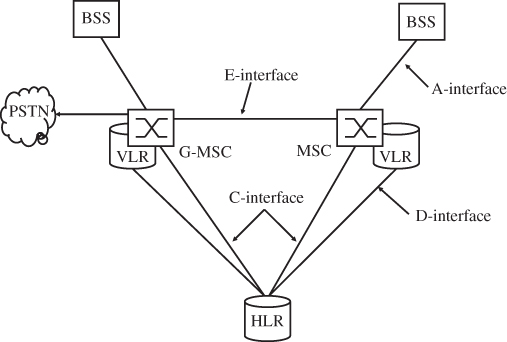1.6 The Network Subsystem
The most important responsibilities of the NSS are call establishment, call control and routing of calls between different fixed and mobile switching centers and other networks. Other networks are, for example, the national fixed-line network, which is also called the Public Switched Telephone Network (PSTN), international fixed-line networks, other national and international mobile networks and Voice over Internet Protocol (VoIP) networks. Furthermore, the NSS is responsible for subscriber management. The nodes necessary for these tasks are shown in Figure 1.9 and are further described in the following sections.
Figure 1.9 Interfaces and nodes in the NSS.

1.6.1 The Mobile Switching Center (MSC)
The MSC is the central element of a mobile telecommunication network, which is also called a Public Land Mobile Network (PLMN) in the standards. In a classic circuit-switched network, all connections between subscribers are managed by the MSC and are always routed over the switching matrix even if two subscribers that have established a connection communicate over the same radio cell. In a virtual circuit-switched network, the MSC is split into two parts: the MSC Server (MSC-S) and the MG. The IP-based MG replaces the switching matrix while the MSC-S contains the same logic for subscriber management and call control as the central processing unit (CPU) of a classic ...
Get From GSM to LTE: An Introduction to Mobile Networks and Mobile Broadband now with the O’Reilly learning platform.
O’Reilly members experience books, live events, courses curated by job role, and more from O’Reilly and nearly 200 top publishers.

